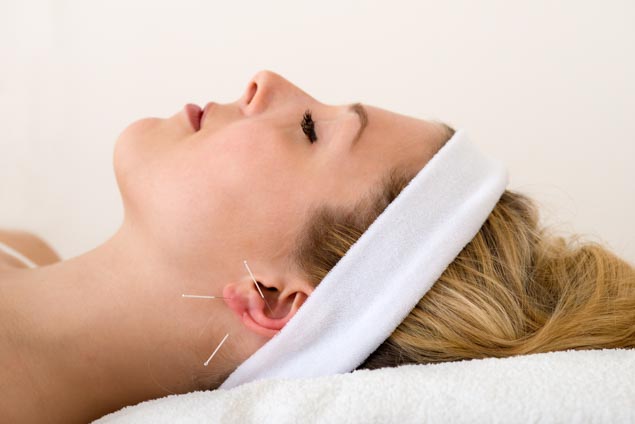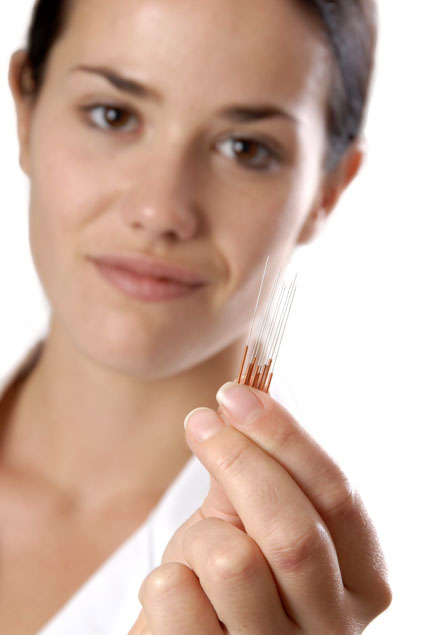Scientific research confirms that acupuncture is safe and effective for preventing and alleviating migraine headaches.
Studies demonstrate that acupuncture is an effective method for relieving migraines. Small clinical studies and large scale meta-analyses confirm the efficaciousness of acupuncture. Additional research demonstrates that acupuncture is an effective alternative to medications for the treatment of migraines with acupuncture demonstrating superior positive patient outcomes in both short and long-term results.

A large body of scientific evidence demonstrates that acupuncture is effective for the relief of migraines. From small clinical studies to large scale analyses, acupuncture has been proven both safe and effective. In addition, researchers find true acupuncture more effective than sham acupuncture.
University of Louisville (Kentucky) doctors published findings in Pediatric Emergency Care. Their approach was to employ auricular acupuncture for the purposes of evaluating the “utility and adverse effects of auricular acupuncture in the treatment of pediatric migraines in the ED [emergency department].” The doctors note, “There were no adverse events associated with any patient during the study.” The doctors conclude, “With all subjects showing improvement or resolution of migraine headache, this pilot study introduces an alternative intervention to pediatric migraine management. . . . auricular acupuncture seems to be a valid alternative.”
Dr. Graff, MD and Dr. McDonald, MD (University of Louisville) recommend additional research based on their findings. Their study was limited by sample size and the use of a relatively non-invasive type of auricular acupuncture employing the use of tiny auricular semi-permanent gold needles. The doctors add, “Auricular acupuncture seems to be well tolerated in children and adolescents with migraines. This experimental protocol provides a unique approach to the pediatric patient with an acute migraine in the ED.”
RMIT University and Royal Melbourne Hospital researchers find acupuncture effective for the relief of migraines (Wang et al.). They note, “Acupuncture can be used as alternative and safe prophylaxis for frequent migraine. Our recommendation is that practitioners treat migraine sufferers twice per week for at least eight weeks.” Their controlled study documents that sham acupuncture does not produce the significant positive patient outcomes as in true acupuncture. The researchers note that “more participants in the RA [real acupuncture] group used less pain killers as relief medication than in the SA [sham acupuncture] group” at the end of the treatment regimen. In addition, the total number of days with a migraine was significantly lower in the real acupuncture group as compared with the sham acupuncture group. Wang et al. document that 73% of real acupuncture patients had a 50% or greater reduction in the number of days with a migraine whereas the sham acupuncture group had a 29% reduction.

The researchers note, "The present trial showed that acupuncture was effective in reducing migraine days, as well as effecting a reduction of medication consumption and improvement in quality of life, when compared with sham acupuncture." They add that the “results demonstrated that manual acupuncture can be an effective and a safe prophylaxis for frequent migraine sufferers.” The primary acupuncture points used in the study included the following:
- Fengchi (GB20)
- Taiyang (Ex-HN5)
- Shuai Gu (GB8)
- Hegu (LI4)
The supplementary acupuncture points based on differential diagnostic pattern variations included the following:
- Baihui (DU20)
- Xingjian (LR2)
- Taichong (LR3)
- Taixi (KI3)
- Xuanzhong (GB39)
- Sanyinjiao (SP6)
- Shang Xing (DU23)
- Zusanli (ST36)
- Feng Long (ST40)
- Zhongwan (CV12)
- Yinlingquan (SP9)
- Xuehai (SP10)
- Ashi point
MRI studies are consistent with the aforementioned migraine research. MRI research demonstrates that acupuncture “induce[s] different cerebral glucose metabolism changes in pain-related brain regions and reduce[s] intensity of pain” for patients with migraines. In a randomized controlled PET-CT neuroimaging investigation, acupuncture was found effective for the alleviation of migraine pain.
The researchers documented that acupuncture raised brain glycometabolism in specific regions: middle temporal cortex, orbital front cortex, middle frontal gyrus, angular gyrus, post cingulate cortex, precuneus, middle cingulate cortex. Simultaneously, acupuncture lowered glycometabolism in the specific brain regions of migraine patients: parahippocampus, hippocampus, fusiform, postcentral gyrus, cerebellum. The study demonstrates that different acupuncture point selections caused predictable and repeatable changes in brain glycometabolism. Acupuncture point specificity was confirmed using MRIs, i.e., specific acupuncture points have specific effects on brain responses and related treatment outcomes.
In other research, Tianjin University of Traditional Chinese Medicine researchers achieved a 100% total effective rate with an 88.6% complete recovery rate for the treatment of migraines with acupuncture and cupping. The primary acupuncture points used in the study included:
- Taiyang, extra point
- Touwei, ST8
- Yintang, extra point
- Baihui, DU20
- Fengchi, GB20
- Waiguan, TB5
- Taichong, LV3
- Sanyinjiao, SP6
- Zhongfeng, LV4
- Taixi, KD3
- Zusanli, ST36
- Shanzhong, CV17
Cupping was applied to back shu (beishu) acupuncture points. Acupuncture was applied twice per week for eight continuous weeks. Needle retention time was twenty minutes per session and manual reinforcing and reducing techniques were applied. When the researchers tried the treatment protocol without cupping and acupoint CV17, the total effective rate dropped from 100% to 94.3% and the complete recovery rate dropped from 88.6% to 62%. The findings suggest that cupping and acupoint CV17 have important clinical benefits for patients with migraines.
Additional research finds acupuncture more effective than valproic acid for the treatment of migraines (Facco et al.). In the study, acupuncture patients required less rizatriptan and had significantly lower pain intensity levels due to migraines than valproic acid patients. Acupuncture patients had no adverse side effects and valproic acid patients had a 47.8% side effect rate.

Zhang et al. determined that the frontal and temporal lobes have “decreased functional connectivity” in migraine sufferers. Their MRI investigation demonstrates that acupuncture restores functional connectivity in those regions. After a four week course of acupuncture therapy, migraine sufferers “showed significantly increased functional connectivity in the bilateral superior frontal gyrus, medial frontal gyrus, precuneus, inferior parietal lobule, posterior cingulate cortex, cingulate gyrus, superior temporal gyrus, middle temporal gyrus, and supramarginal gyrus as compared with before acupuncture treatment.” In addition, the researchers concluded that acupuncture decreased the frequency and duration of migraine attacks after a four week course of acupuncture care.
Guo et al. find acupuncture more effective than flunarizine hydrochloride for controlling migraines. In their investigation, acupuncture combined with tuina had a total effective rate of 93.8% whereas flunarizine hydrochloride achieved a 63% total effective rate. In addition, patients receiving acupuncture with tuina had significantly fewer relapses than the patients taking the drug. As a result of the findings the researchers conclude, “Combining electroacupuncture and local tuina can obtain better effect and lower relapse rate than oral Flunarizine Hydrochloride capsules in migraine patients.”
Lin et al. conducted a randomized controlled trial of eighty-seven migraine patients. The following acupuncture points produced a 95.2% total effective rate measured six weeks following acupuncture and 88.1% measured three months following acupuncture treatments:
- Hegu (LI4)
- Taichong (LR3)
- Fengchi (GB20)
- Shuaigu (GB8)
- Qiuxu (GB40)
- Zulinqi (GB41)
Scott et al. conclude that acupuncture is “of comparable efficiency to several proven drug therapies for the treatment and prevention of migraine[s].” The meta-analysis conducted by Scott et al. involved the investigation of twenty-five randomized controlled trials involving a sample size of 3,004 migraine sufferers. Given these and the aforementioned findings, the consensus of modern research is that acupuncture is both safe and effective for the treatment of migraines.
References:
Graff, Danielle M., and Mark J. McDonald. "Auricular Acupuncture for the Treatment of Pediatric Migraines in the Emergency Department." Pediatric Emergency Care (2016).
Wang, Yanyi, Charlie Changli Xue, Robert Helme, Cliff Da Costa, and Zhen Zheng. "Acupuncture for Frequent Migraine: A Randomized, Patient/Assessor Blinded, Controlled Trial with One-Year Follow-Up." Evidence-Based Complementary and Alternative Medicine 2015 (2015).
Yang, Jie, Fang Zeng, Yue Feng, Li Fang, Wei Qin, Xuguang Liu, Wenzhong Song, Hongjun Xie, Ji Chen, and Fanrong Liang. "A PET-CT study on the specificity of acupoints through acupuncture treatment in migraine patients." BMC complementary and alternative medicine 12, no. 1 (2012): 1.
Jin SS, Du YZ, Han L, Liao C & Gu WL. (2015). Observations on the Efficacy of Acupuncture at Point Shanzhong (CV17) plus Cupping on Back-Shu Points in Treating Migraine. Shanghai Journal of Acupuncture and Moxibustion. 34(3).
Facco, E., et al. "Acupuncture Versus Valproic Acid In The Prophylaxis Of Migraine Without Aura: A Prospective Controlled Study." Minerva anestesiologica (2013).
Zhang, Yong, Kuang-shi Li, Hong-wei Liu, Cai-hong Fu, Sheng Chen, Zhong-jian Tan, and Yi Ren. "Acupuncture treatment modulates the resting-state functional connectivity of brain regions in migraine patients without aura." Chinese Journal of Integrative Medicine (2015): 1-9.
Guo, Qing, Yu Hua, Hai-qin Wang, Ying Li, and Quan Ji. "Therapeutic effect observation on combining electroacupuncture and tuina for migraine." Journal of Acupuncture and Tuina Science 12, no. 3 (2014): 174-179.
Lin, X. M., X. Yao, and Z. Di. "[Acupuncture at" Siguan" combined with Gallbladder Meridian acupoints for migraine: a randomized controlled trial]." Zhongguo zhen jiu= Chinese acupuncture & moxibustion 34, no. 10 (2014): 947-950.
Scott SW, Deare JC. Acupuncture for migraine: a systematic review. ‘Aust J Acupunct Chin Med’ 2006;1(1):3-14).


